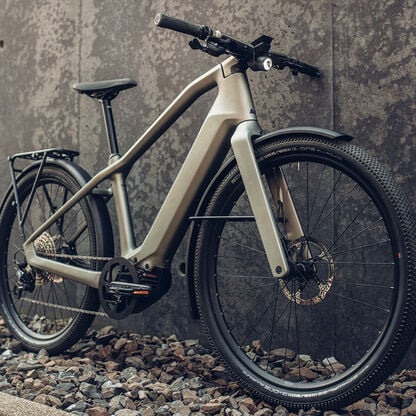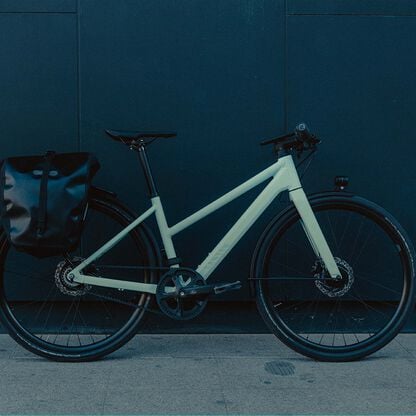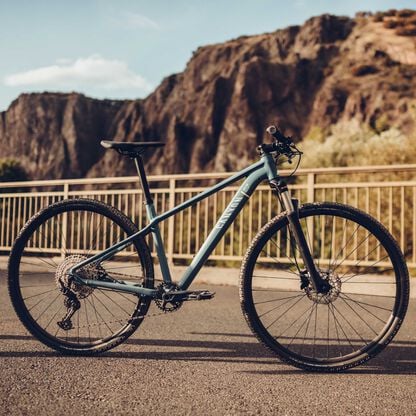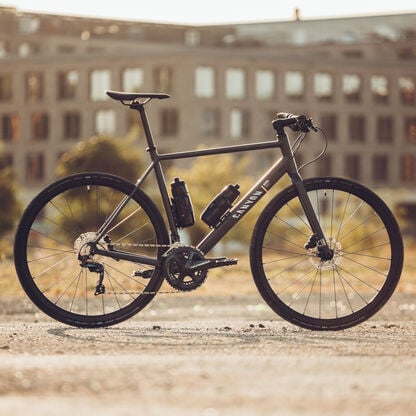Cycling in winter: Preparation and maintenance tips
Cycling in winter? Well, of course! With our tips, harsh winter weather can't harm you or your bike.


Contents
Cycling in winter is fun – but only when you’re well prepared. With a winter-proof bike, an adapted riding style and the right equipment, you can ride safely and comfortably even on ice and snow. And after the winter tour, it's not just you who deserves a pampering programme, but your bike too.
Preparation for winter cycling
You’re riding your bike along empty bike paths and watching the snow glisten in the sun. The fresh air fills your lungs and you know that as a pollen allergy sufferer, you don’t have to worry about hay fever: Biking can be nice in winter.
On a typical winter tour, you wear your warmest clothing and choose paths and roads that are as ice-free as possible. You should also prepare your bike well for the winter season, as road salt, slush and dirt will not leave it unscathed. You will have to replace the chain, cassette and tyres in no time at all if your bike is not winter-proof.
Do you need a winter bike?
Of course, you can use a particularly durable bike that will accompany you through the deepest winter. This will prevent salt-covered wet roads from damaging your valuable components. A winter bike is usually similar to the bike you ride in the summer, but it often has a steel or aluminium frame and more robust components.
We know that not everyone can afford a second bike for winter. So how do you save money and make your current bike winter-proof?

Improve winter tyres, tyre pressure and visibility
Winter tyres are not compulsory for bicycles in Germany. Nevertheless, the investment makes sense, especially if you want to cycle more often in the snow. Winter tyres are made from a softer rubber compound and have a coarse tread pattern. This means that they offer significantly more grip and traction than standard tyres. It is best to choose slightly wider tyres. Before buying, check the maximum tyre clearance on your bike to make sure they will fit.
There are also winter tyres that are fitted with studs. They ensure greater safety on packed snow and icy surfaces. On a dry or wet road, however, winter tyres with studs run more heavily.
If you don't want to fit special winter tyres, you should at least use all-weather tyres. Alternatively, you can reduce the air pressure of your tyres slightly to increase their contact area and grip. However, make sure that you do not go below the minimum pressure.
Whether city bike, racing bike or e-bike: Good lighting is a must for your bike, especially if you are travelling in traffic. As a cyclist, you are less visible in winter, whether due to rain, fog or haze - or when night falls during a tour.
Check if the lighting complies with local laws (StVZO if you are in Germany). The basic equipment includes a front headlight with white reflector, a red rear light with reflector, yellow reflectors on the pedals and spoke reflectors, spoke sleeves or reflector strips on the front and rear wheels. Make sure your lighting set is charged. Use it even if you think it’s bright enough outside. It’s better to be on the safe side!
Safety in snow and ice
Cycling in snow and icy conditions requires an adapted riding style. These tips will help you stay fall-free:
- Ride with foresight and reduce your speed. Keep a sufficient distance from other road users and parked vehicles.
- Allow for a longer braking distance: Brake early and gradually. Mainly use the rear brake.
- On hard snow and icy surfaces, you should neither pedal nor brake on curves.
- Have you hit a patch of black ice? Now it’s time to stay calm: Let yourself coast without braking and don't steer.
- Select the lowest assistance level when starting off on an e-bike. Accelerating too quickly can cause the rear wheel to slip.
Take particular care with wet road markings, manhole covers, tram tracks, wooden bridges and cobblestones. Cycle paths paved with red bricks can also be very slippery when wet.

Special features of mountain biking in winter
Are you thinking about riding your mountain bike in winter too? Mountain biking is great all year round. If you normally ride with clipless pedals, consider whether platform pedals might be more suitable for winter. Due to the typically slippery conditions, it's better if you can quickly put your foot down to stay on your mountain bike. You will also have to get on and off the bike more often, as the trails are usually in worse condition in winter. Mountain bike shoes without cleats give you a better grip when walking.
In addition, mud often gets stuck in the cleats. This sometimes makes it difficult to find your way back onto the pedals. On the other hand, mud doesn't stick to platform pedals so easily.
If you want to know more about the benefits of platform pedals vs. clipless pedals, check out our guide to help you make the right decision.
Bicycle maintenance in winter
Before the real winter weather sets in, you should have your bike serviced. If you do it yourself at home, pay attention to the following points:
- Check that the bearings (headset, bottom bracket and seat post) are sufficiently lubricated.
- Check if the brake or shift cables have stretched (if so, they must be replaced).
- Check the drivetrain for chain wear – the chain should fit properly on the teeth of the chainrings and sprockets.
- Check your brakes and bleed them if you know how.
Being able to brake perfectly in dark, slippery and unpredictable conditions is crucial. Because brake pads are no friend of rough weather, you should check them for wear before and after every ride.
Depending on the distances you intend to cover in winter, it is advisable to order replacement brake pads as a precaution. This means you can replace your brake pads in no time at all when they are worn out.
Cleaning, drying and maintenance of components
A dirty wheel quickly becomes a defective wheel. Caked-on mud and grit can quickly corrode important components and cost you more money in the long run. Proper care is therefore essential.
Rinse your bike with warm water and a brush after every ride to remove the worst of the dirt. You can also add a few drops of bike cleaner. When cleaning your e-bike, first remove the battery and set it aside. After washing, dry the bike with a cloth – done!
Once a week, you should clean your bike thoroughly. Remove dirt and old oil from your chain and relubricate it. Find out how to clean your bike chain properly on the blog.

Tips for storing your bike in winter
Cool temperatures do not affect a bicycle, but it becomes problematic when moisture comes into play. If the wheel gets wet, rust can form. It is not only the frame that is vulnerable, but also the moving parts such as the chain and brakes.
Protection against moisture and cold
It is best to store your bike in a dry and frost-free place, especially if you want to store it for a longer period of time. Suitable options include a bike cellar, a garage, a bike shed, or a garden shed. Your e-bike doesn't have to be kept inside your flat. It is only important that you remove the battery and store it at room temperature. Cold can certainly damage the battery. Check out our blog for tips on how to care for your battery.
Useful accessories and clothing for winter rides
Admittedly, mudguards are the least sexy bicycle accessory, but just this once, comfort comes before style. Mudguards not only protect the frame and components in bad weather, but also help to keep your outfit dry and clean.
Speaking of outfits: In the darker months of the year, light-coloured cycling clothing ensures that you are more visible. Reflective appliqués on the jacket and rucksack further increase visibility. It is best to dress according to the onion principle. This means you wear multiple layers on top of each other. The bottom layer should ideally consist of breathable underwear. The top layer is a water-repellent and windproof cycling jacket and winter cycling trousers. Overtrousers that can be worn over normal trousers are practical for commuters and everyday cyclists.
At Canyon, we value your safety when riding in winter. Check out our winter safety bike accessories to stay safe and visibly on the road.
Have you caught a cold despite wearing thick winter clothing? Check out our blog to see if you should cycle with a cold.
Make your bike winter-proof
Winter takes its toll on both the rider and the bike. Take the extra time to check your bike before and after your rides. Your bike and its components will thank you for it and reward you with a long winter to discover your surroundings near and far.
Discover our Hybrid Bikes
Did this article help?
Thank you for your feedback








